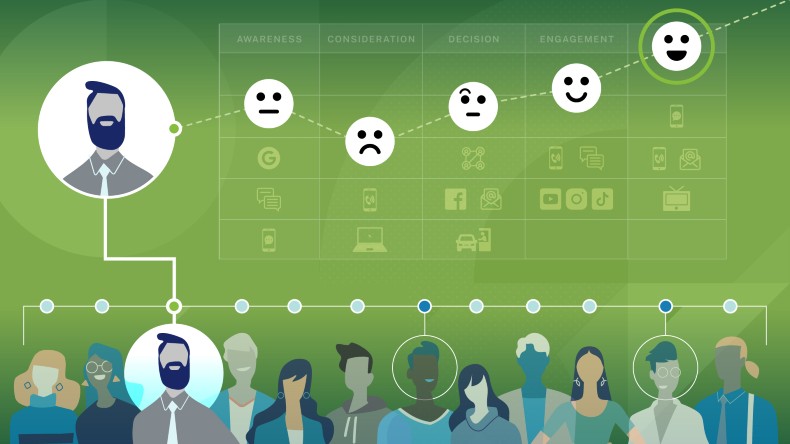Building any kind of business strategy begins with an understanding of your customers and their needs. Because if you don't know to whom you're selling, it's nearly impossible to know what to sell them and how to go about selling.
And that is the intersection of business and design... where customer journey-mapping comes in to help you understand your audience and better tailor your strategy to their needs.
At its core, customer journey-mapping is a method of developing empathy for your target audience. When you successfully do that, you can better serve them in the short-term, and build up trust in your entire brand in the long term.
Now, let's break down the basics of customer journey-mapping, including why it's important and how it can have major impacts on your business.
What Is Customer Journey-Mapping?

Customer journey-mapping is a process that helps you better understand your customer's experience throughout their buying process. It follows a specific picture of what a customer's journey looks like and how that might affect how they interact with your company.
By charting their entire journey, we can pinpoint gaps in service, identify key opportunities for improvement, and optimize the total customer experience.
It's not just a generalized idea of your audience, either. Proper customer journey-mapping relies heavily on buyer personas that present an insightful view into the minds and behaviors of your target audience. They are archetypes and demographics of a specific customer or prospect you're aiming to attract or those with whom you are already actively engaged.
A buyer persona might include detailed information about everyday habits, hobbies, level of education, and/or personal and professional goals. You can use a variety of methods to build personas, but they always rely on research into your actual customers to develop an understanding of what they need. That research might require surveys, interviews, or other data-collection methods.
Once you're equipped with buyer personas, you can begin the process of mapping their journey as a prospective customer. Maybe you're interested in what steps they take to buy a particular product, or how they seek out a type of service. Either way, you want to identify their goals and any related pain points at each step of their journey.
Knowing their goals helps you identify areas where you may be able to step in and meet their needs, thereby building trust in your brand as a reliable solution provider. When you can do so consistently, you elevate your brand and build confidence in its willingness and ability to deliver on its promise.
That leads to repeat customers, brand advocates, and ultimately long-term growth.
Knowing your customers' pain points helps you find opportunities to provide a uniquely strong experience that addresses issues they've had with other brands. Doing that is key for differentiating your brand from the competition, and it will communicate that you understand their challenges and are there to assist.
Remember, your brand exists in the customer's mind; it's made up of their perceptions and experiences with your company. If you can understand their drivers and the problems they're facing and address those sufficiently, it can do wonders for your brand's reputation in the marketplace, leading to more conversions and satisfied customers who are more likely to become advocates of your brand.
Why Is Journey-Mapping Important?
It can be easy to assume that you know your customers and know them well— especially if you have an established brand and have served your customers for a long time. But in today's rapidly evolving market, audience behaviors are constantly changing, including the ways they interact with brands. Those changes should be reflected in your strategy in so that you can keep up with your customers' needs.
You are not your audience. Many companies "think" they know who their customer is. But theirs is typically a narrow view. Building personas widens that view and opens up opportunities: not just what they buy but HOW they buy, WHY they buy, and why they DON'T buy. Journey-mapping can help identify where the prospective customer may drop out of the buying journey and thus address these potential issues before they become a lost opportunity.
Nowadays, users expect to have more-customized experiences when they engage with brands. Although the preferred degree of personalization differs by generation, almost all customers are becoming more accustomed to brands that understand who customers are and are better able to help them in personalized ways. Customer journey-mapping helps you understand the various phases of your target audience's experience, which in turn helps you tailor and deliver touchpoints that will resonate with their unique needs and feelings.
Journey-mapping not only helps build empathy with your audience but also optimizes the experience to increase the likelihood of getting them to convert, purchase, join, or engage with your brand. It helps identify sticking points to produce desired results and charts a path toward your corporate goals, in turn generating revenue and strengthening brand value.
Without journey-mapping, you run the risk of creating websites, campaigns, or total brand experiences that feel disjointed and divorced from your customers' expectations.
Users can tell when you don't understand their needs, and they will be quick to move onto the next option.
Where Do I Start?
As with most initiatives, journey-mapping begins with a significant amount of research. As we mentioned earlier, all journey-mapping is based on a clear understanding of your audience through buyer personas. You should look to gather as much data as they can on your audience and begin building detailed personas that help you visualize the type of people you want to engage.
If that data isn't yet available, you can start with a hypothetical picture of who your audience is. But it's crucial to back that up with data as soon as possible and confirm its accuracy with diligent research.
Once you have a solid understanding of your audience, you can start to define the scope of your journey map according to their goals.
If the purpose of your journey map is to improve the efficacy of a specific campaign, maybe you're primarily looking at a specific phase of the customer journey and determining how best to target it.
On the other hand, if your goals are more omnichannel or they span a longer period of time, then your customer journey-mapping should break down each phase of the journey and the ways your messaging changes according to the stage at which they encounter your brand.
No matter the scope of your journey-mapping, the goal should be supporting customers in their decision-making. It's all about figuring out where your audience is and then matching your message to the particular phase of their journey. Building those experiences will help customers approach you at the moment that makes the most sense for them.
Building a Brand Experience
In short, your brand is defined by the experiences you provide to your users. When that experience is thoughtful and researched, it results in customers who can trust your expertise. When it isn't, it can lead to dissatisfaction and reduced brand equity.
BrandExtract builds value by inspiring belief in people and organizations. We align your brand strategy with your corporate strategy to create exceptional opportunities for growth. To learn more about how your branding and marketing can meet the needs of your audience, reach out to a strategist today.
Written by Cynthia Stipeche, director of brand experience, BrandExtract.




